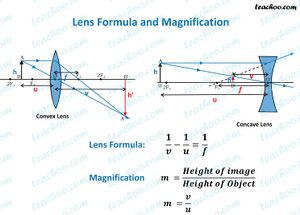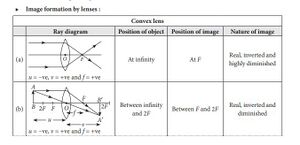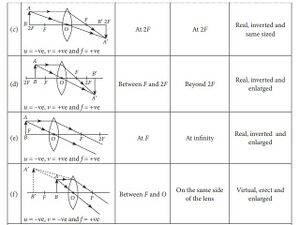Refraction, lens equation, optical power
A lens is most commonly used for refraction imaging. A lens is the simplest optical system. It consists of a transparent medium (most often glass, sometimes plastic) bounded by two refractive surfaces (usually spherical).
There are two types of lenses:
- Converging : parallel rays intersect at the image focus the focus is real (f > 0);
- Diverging : parallel rays diverge in the image focus; they intersect during retrograde extension at the subject focus the focus is virtual (f < 0).
A lens can be:
- Thin : the thickness of the lens is negligible compared to its focal length;
- Thick : the thickness of the lens is not negligible compared to its focal length.
A lens is called thin if its thickness is small compared to the radii of its spherical surfaces. In a homogeneous environment: .
Lens equation[edit | edit source]
Thick lens[edit | edit source]
- n2 : index of refraction of the lens material n1 : index of refraction of the surrounding medium;
- r1 a r2 : radii of curvature.
Thin lens[edit | edit source]
- a : object distance,
- a‘ : image distance,
- f : focal length.
This equation is valid for both converging and diverging lenses. When substituting the values a , a' we follow the sign convention:
- a > 0 : the object is located in the object space (in front of the lens);
- a < 0 : the object is located in the image space (behind the lens);
- a‘ > 0 : the image is located in the image space; it is real;
- a‘ < 0 : the image is located in the object space; it is virtual.
Optical power[edit | edit source]
Optical power is a quantity expressing the refractive power of a lens.
Calculation of optical power[edit | edit source]
- φ : optical power,
- f : focal length.
Unit: diopter (D) = m -1 ( f must be given in meters!). 1 D is the optical power of a lens with a focal length of 1 m. φ > 0 applies to converging lenses and φ < 0 to diverging lenses.
Image formation on ray diagram[edit | edit source]
(Note: The distance of the object ( x ) from the lens: what is the image)
- x > 2f : real, inverted and reduced;
- x = 2f : real, inverted, same size as object;
- x < 2f : real, inverted, magnified;
- x = f : the image is at infinity;
- x < f : apparent, direct, magnified.
In case of a diverging lens, its distance from the lens does not matter. The image is always apparent, direct and reduced.
Links[edit | edit source]
References[edit | edit source]
SVOBODA, Emanuel. Přehled středoškolské fyziky. - edition. 2005. 531 pp. ISBN 9788071963073.
JIŘÍ, Beneš, – DANIEL, – FRANTIŠEK, Vítek,. Základy lékařské fyziky. - edition. Charles University in Prague, Karolinum Press, 2015. 322 pp. ISBN 9788024626451.








